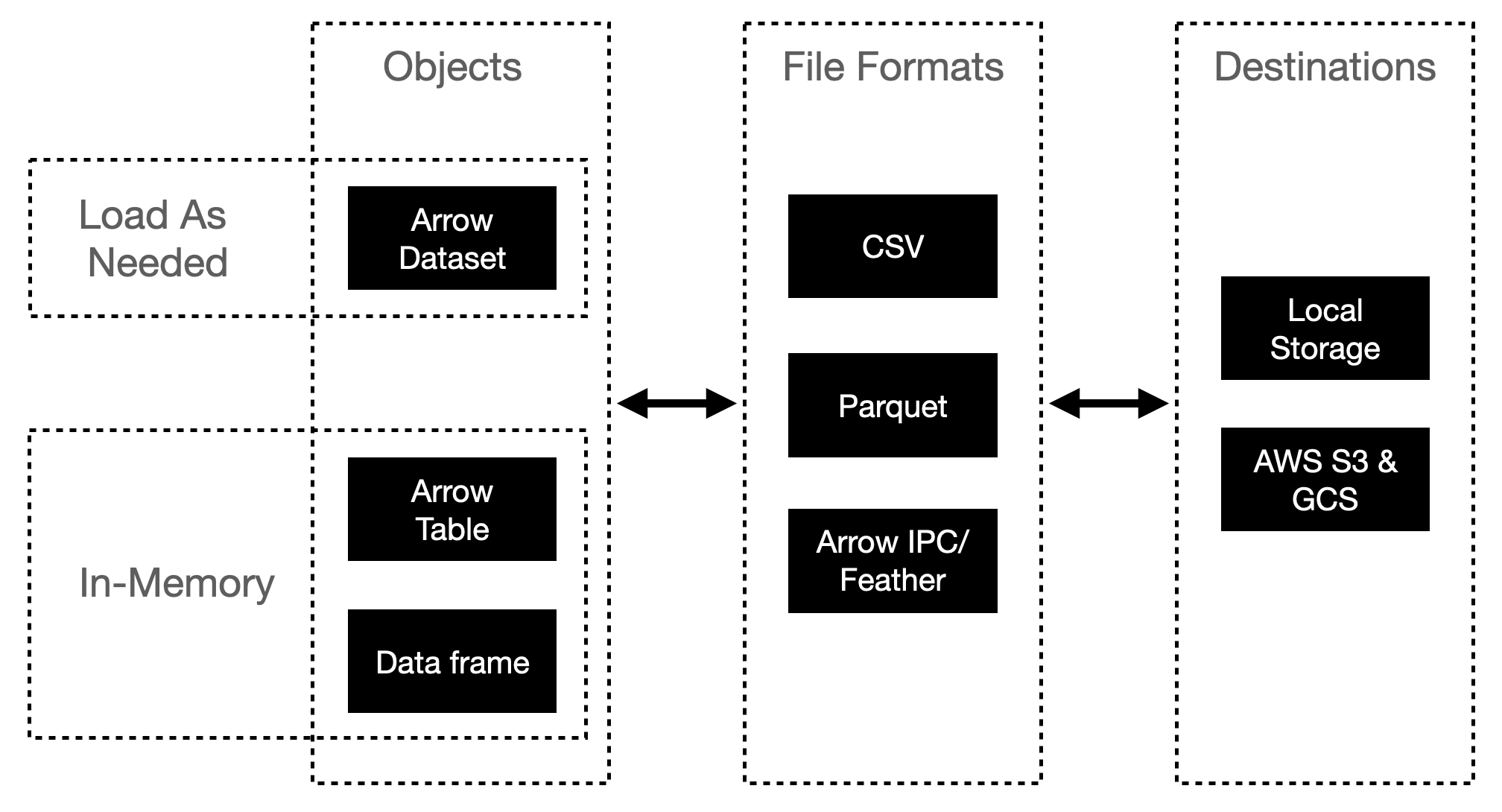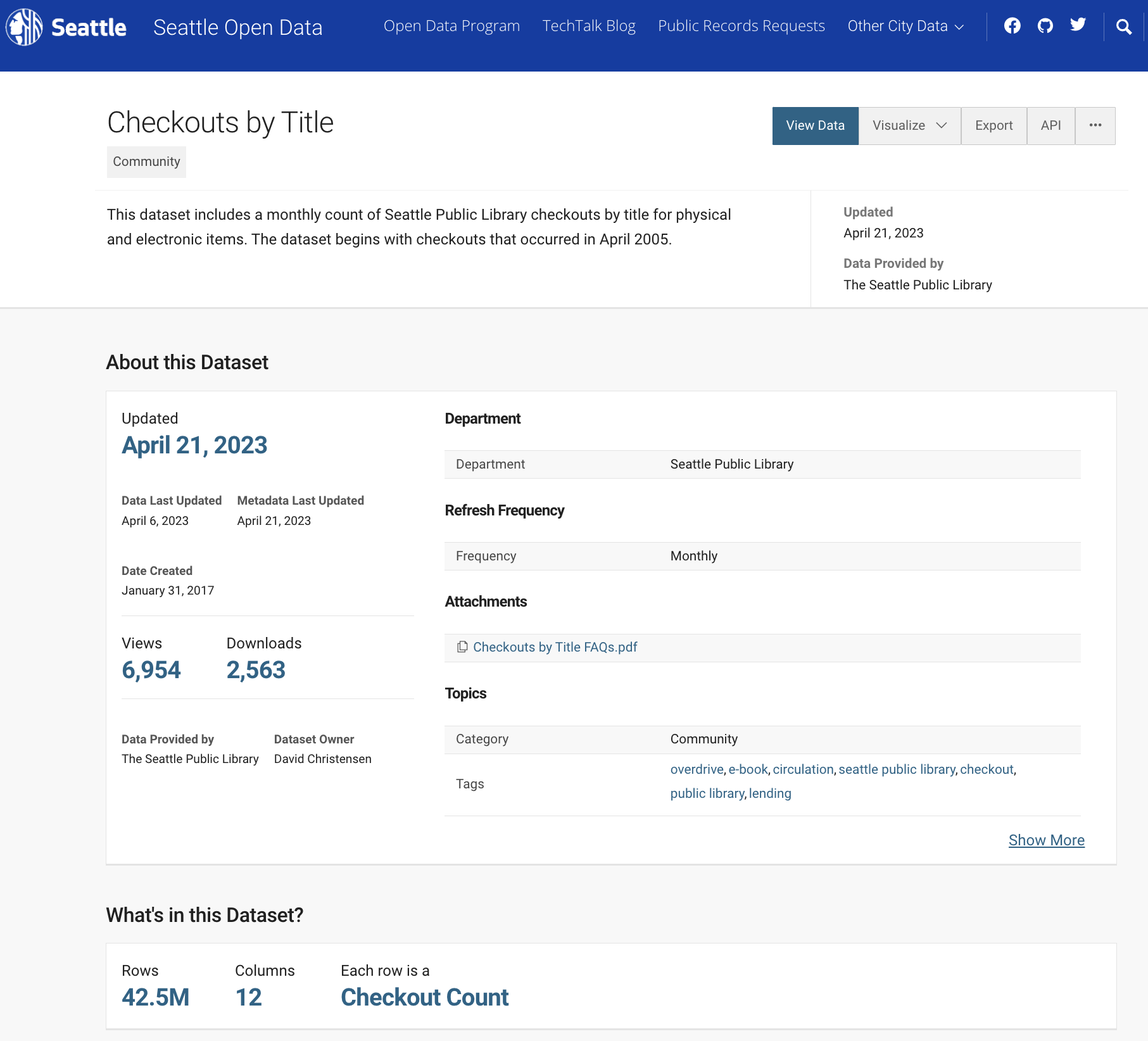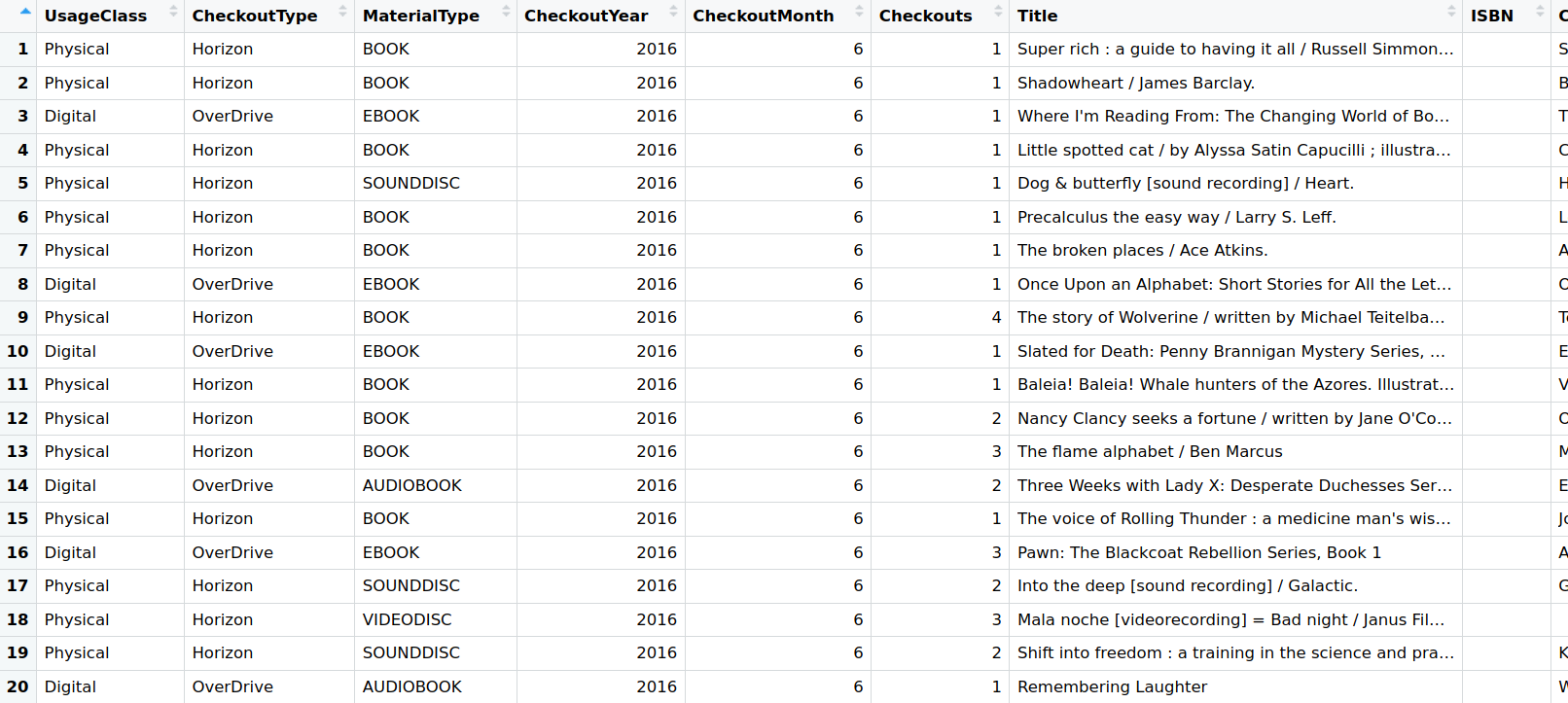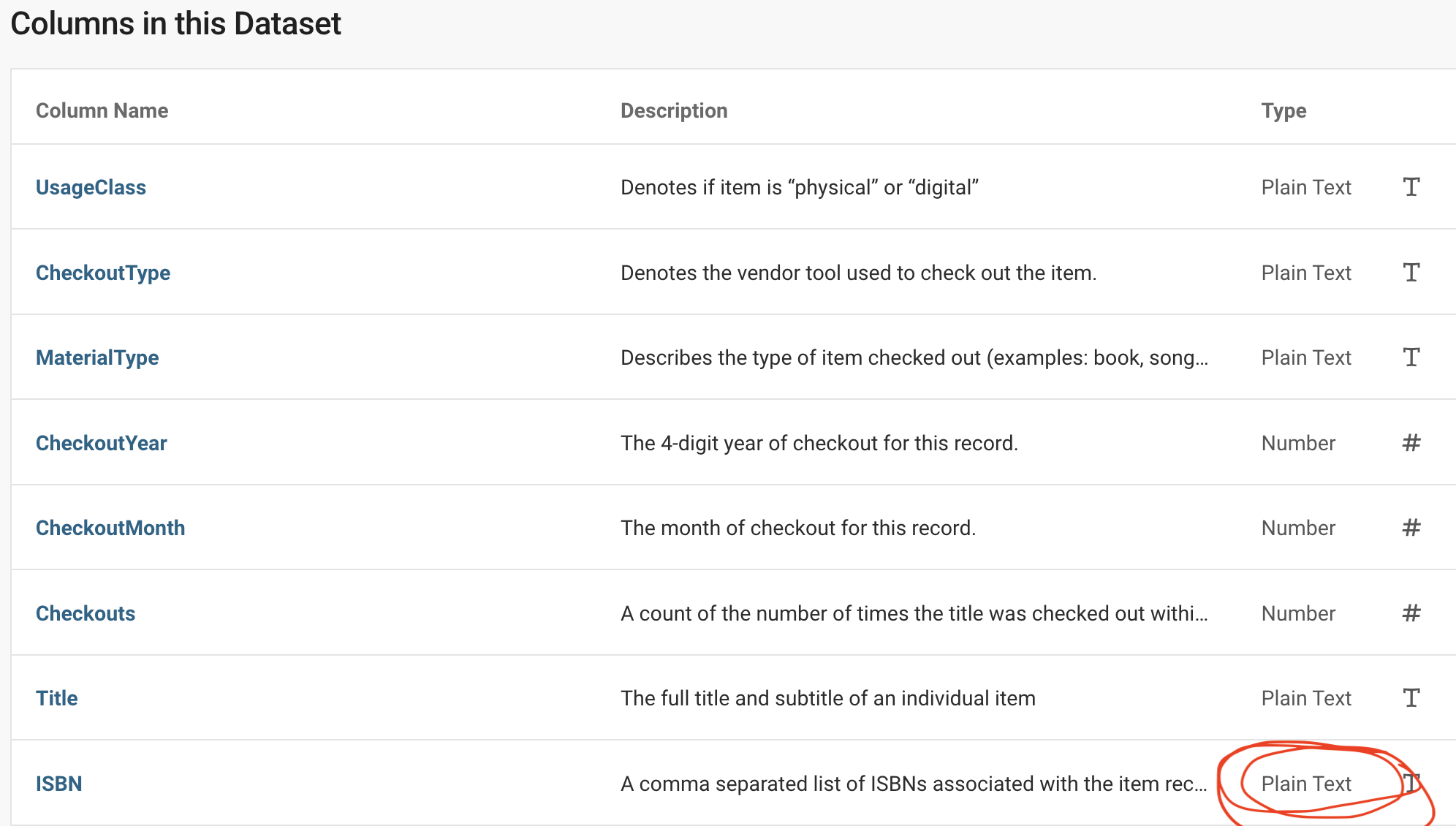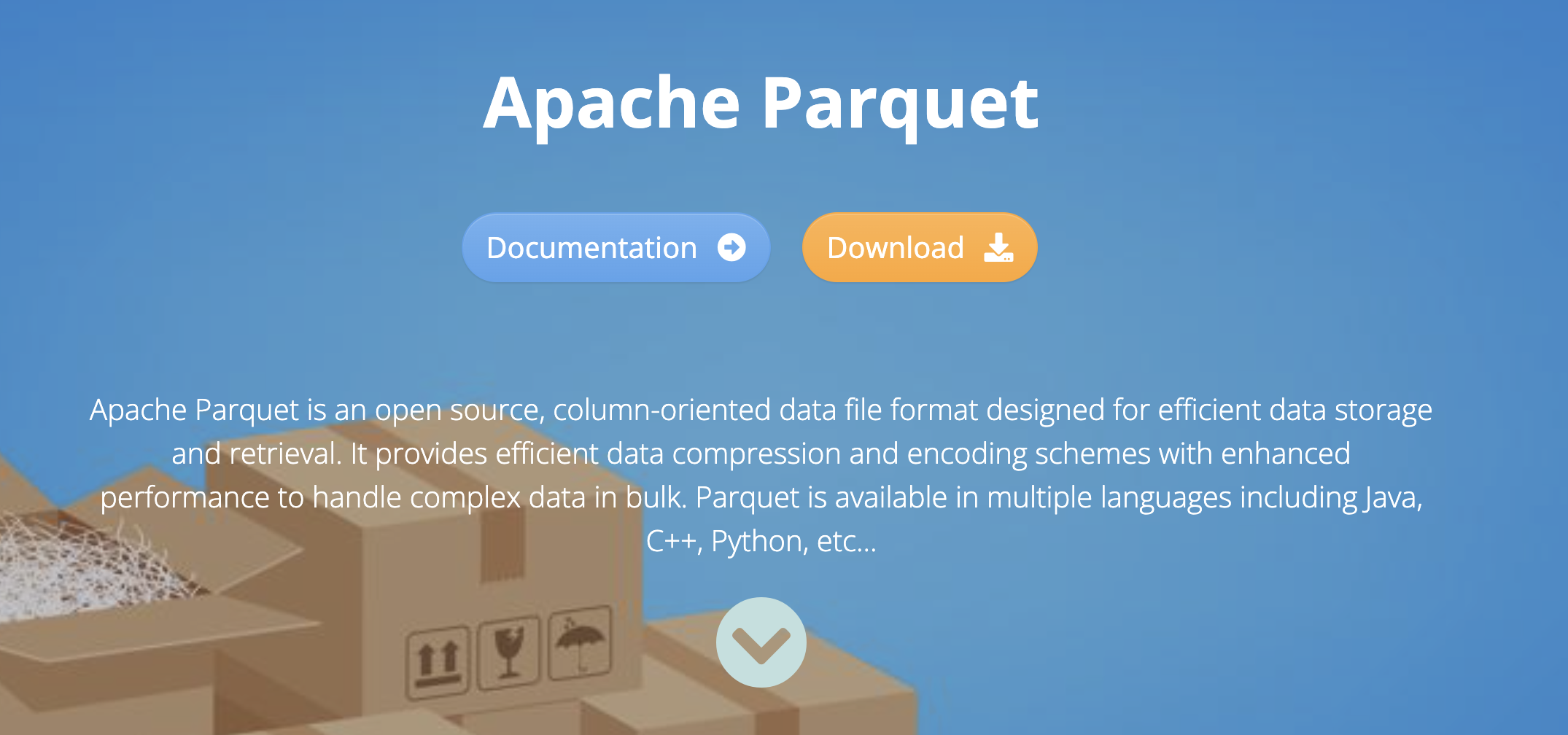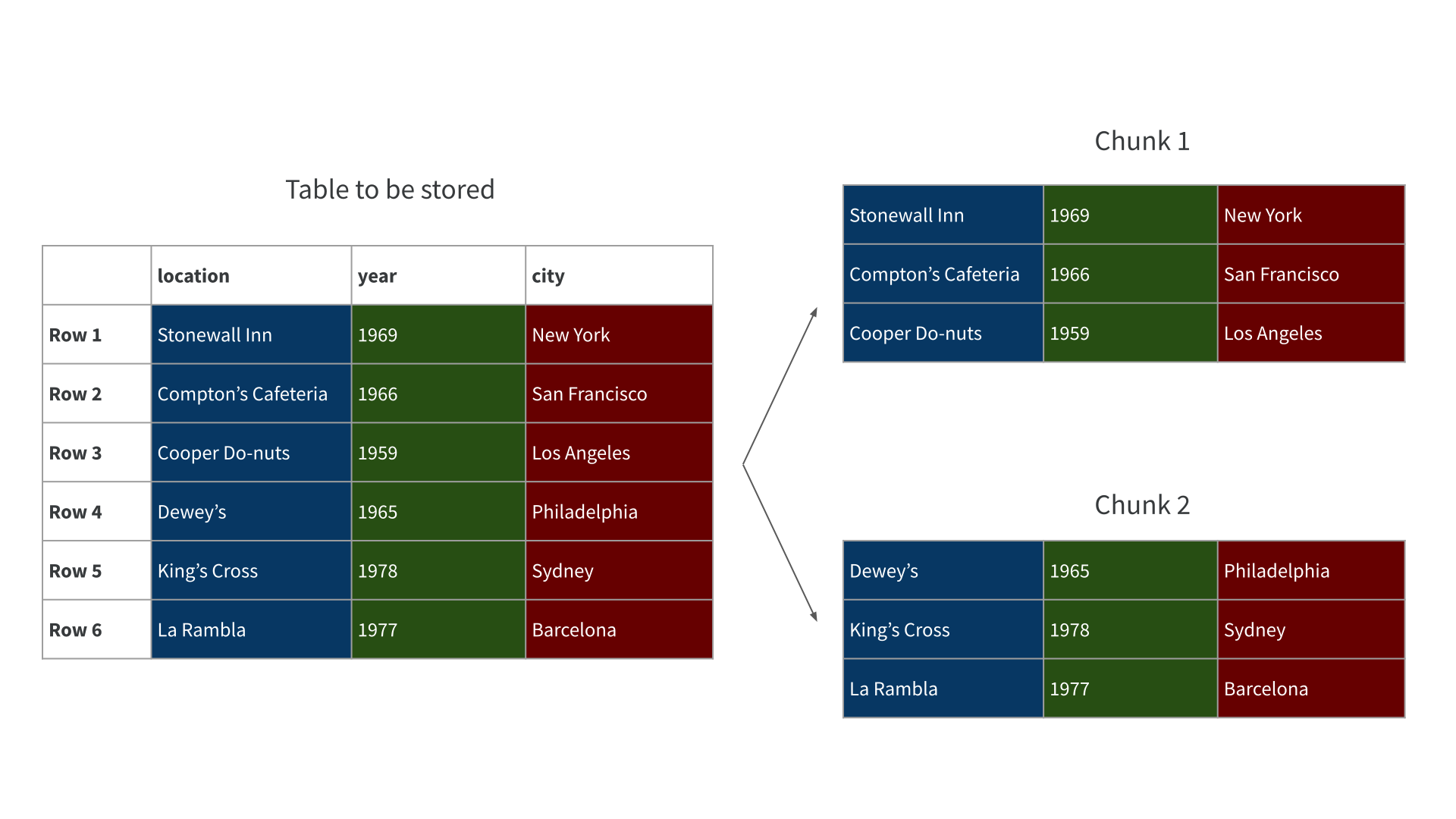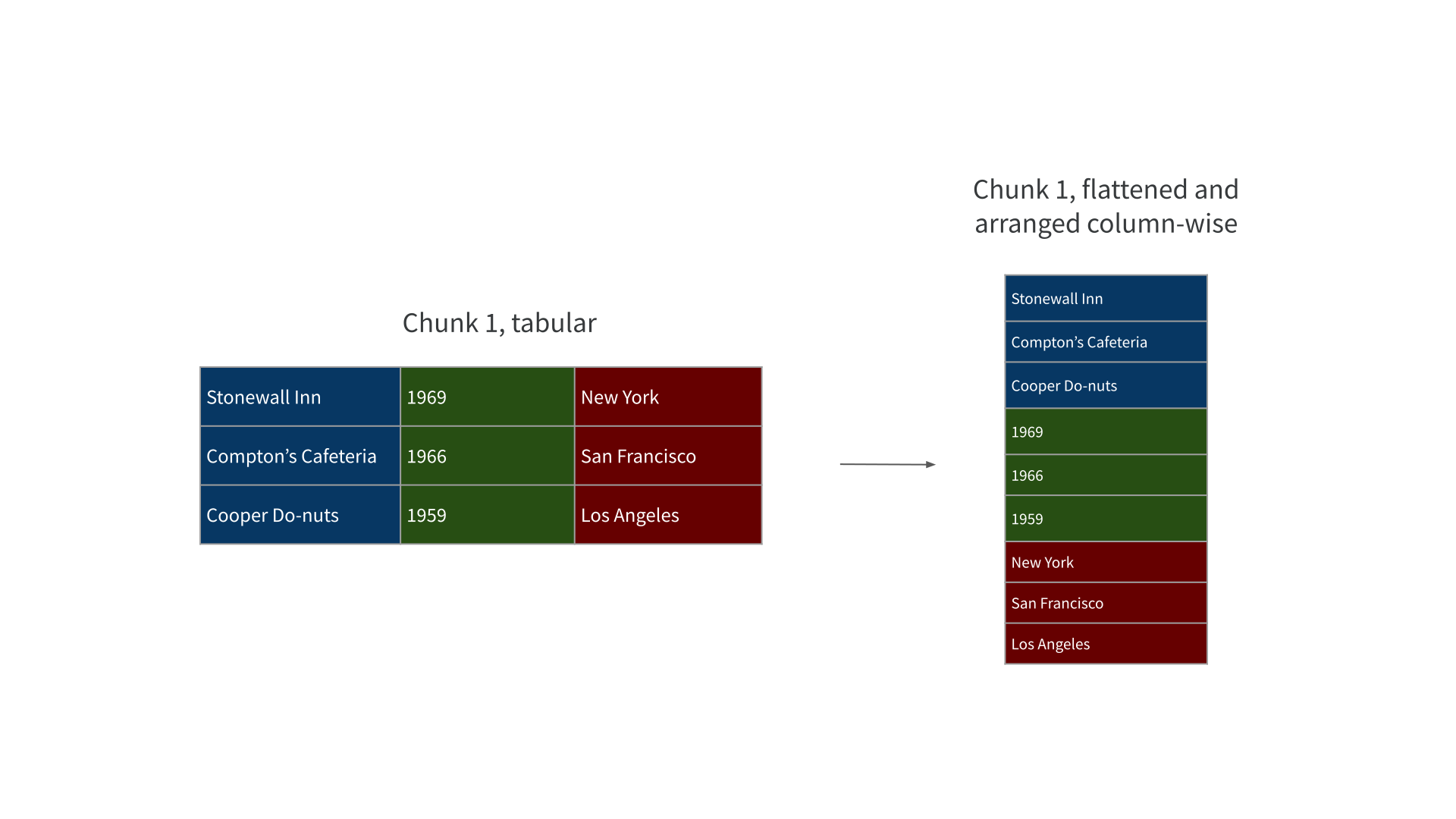Data Engineering with Arrow
Data Engineering
.NORM Files
Seattle
Dataset contents
arrow::open_dataset() with a CSV
library (arrow)library (dplyr)<- open_dataset (sources = "data/seattle-library-checkouts.csv" ,format = "csv" )
FileSystemDataset with 1 csv file
12 columns
UsageClass: string
CheckoutType: string
MaterialType: string
CheckoutYear: int64
CheckoutMonth: int64
Checkouts: int64
Title: string
ISBN: null
Creator: string
Subjects: string
Publisher: string
PublicationYear: string
arrow::schema()
Create a schema or extract one from an object.
Let’s extract the schema:
Schema
UsageClass: string
CheckoutType: string
MaterialType: string
CheckoutYear: int64
CheckoutMonth: int64
Checkouts: int64
Title: string
ISBN: null
Creator: string
Subjects: string
Publisher: string
PublicationYear: string
Parsers Are Not Always Right
Schema
UsageClass: string
CheckoutType: string
MaterialType: string
CheckoutYear: int64
CheckoutMonth: int64
Checkouts: int64
Title: string
ISBN: null
Creator: string
Subjects: string
Publisher: string
PublicationYear: string
International Standard Book Number (ISBN) is a 13-digit number that uniquely identifies books and book-like products published internationally.
Data Dictionaries, metadata in data catalogues should provide this info.
The number or rows used to infer the schema will vary depending on the data in each column, total number of columns, and how many bytes each value takes up in memory.
If all of the values in a column that lie within the first 1MB of the file are missing values, arrow will classify this data as null type. ISBN! Phone numbers, zip codes, leading zeros…
Recommended specifying a schema when working with CSV datasets to avoid potential issues like this
Let’s Control the Schema
Creating a schema manually:
schema (UsageClass = utf8 (),CheckoutType = utf8 (),MaterialType = utf8 (),CheckoutYear = int64 (),CheckoutMonth = int64 (),Checkouts = int64 (),Title = utf8 (),ISBN = string (), #utf8() Creator = utf8 (),Subjects = utf8 (),Publisher = utf8 (),PublicationYear = utf8 ()
This will take a lot of typing with 12 columns 😢
Let’s Control the Schema
Use the code() method to extract the code from the schema:
$ schema$ code ()
schema(UsageClass = utf8(), CheckoutType = utf8(), MaterialType = utf8(),
CheckoutYear = int64(), CheckoutMonth = int64(), Checkouts = int64(),
Title = utf8(), ISBN = null(), Creator = utf8(), Subjects = utf8(),
Publisher = utf8(), PublicationYear = utf8())
🤩
Let’s Control the Schema
Schema defines column names and types, so we need to skip the first row (skip = 1):
<- open_dataset (sources = "data/seattle-library-checkouts.csv" ,format = "csv" ,schema = schema (UsageClass = utf8 (),CheckoutType = utf8 (),MaterialType = utf8 (),CheckoutYear = int64 (),CheckoutMonth = int64 (),Checkouts = int64 (),Title = utf8 (),ISBN = string (), #utf8() Creator = utf8 (),Subjects = utf8 (),Publisher = utf8 (),PublicationYear = utf8 ()skip = 1 ,
FileSystemDataset with 1 csv file
12 columns
UsageClass: string
CheckoutType: string
MaterialType: string
CheckoutYear: int64
CheckoutMonth: int64
Checkouts: int64
Title: string
ISBN: string
Creator: string
Subjects: string
Publisher: string
PublicationYear: string
Let’s Control the Schema
Supply column types for a subset of columns by providing a partial schema:
<- open_dataset (sources = "data/seattle-library-checkouts.csv" ,format = "csv" ,col_types = schema (ISBN = string ()) #utf8()
FileSystemDataset with 1 csv file
12 columns
UsageClass: string
CheckoutType: string
MaterialType: string
CheckoutYear: int64
CheckoutMonth: int64
Checkouts: int64
Title: string
ISBN: string
Creator: string
Subjects: string
Publisher: string
PublicationYear: string
Your Turn
The first few thousand rows of ISBN are blank in the Seattle Checkouts CSV file. Read in the Seattle Checkouts CSV file with open_dataset() and ensure the correct data type for ISBN is <string> (or the alias <utf8>) instead of the <null> interpreted by Arrow.
Once you have a Dataset object with the correct data types, count the number of Checkouts by CheckoutYear and arrange the result by CheckoutYear.
➡️ Data Storage Engineering Exercises Page
9GB CSV file + arrow + dplyr
|> group_by (CheckoutYear) |> summarise (sum (Checkouts)) |> arrange (CheckoutYear) |> collect ()
# A tibble: 18 × 2
CheckoutYear `sum(Checkouts)`
<int> <int>
1 2005 3798685
2 2006 6599318
3 2007 7126627
4 2008 8438486
5 2009 9135167
6 2010 8608966
7 2011 8321732
8 2012 8163046
9 2013 9057096
10 2014 9136081
11 2015 9084179
12 2016 9021051
13 2017 9231648
14 2018 9149176
15 2019 9199083
16 2020 6053717
17 2021 7361031
18 2022 7001989
9GB CSV file + arrow + dplyr
|> group_by (CheckoutYear) |> summarise (sum (Checkouts)) |> arrange (CheckoutYear) |> collect () |> system.time ()
user system elapsed
10.615 1.253 10.356
42 million rows – not bad, but could be faster….
Parquet Files: “row-chunked”
Parquet Files: “row-chunked & column-oriented”
Parquet
“row-chunked & column-oriented” == work on different parts of the file at the same time or skip some chunks all together, better performance than row-by-row
compression and encoding == usually much smaller than equivalent CSV file, less data to move from disk to memory
rich type system & stores the schema along with the data == more robust pipelines
efficient encodings to keep file size down, and supports file compression, less data to move from disk to memory
CSV has no info about data types, inferred by each parser
Writing to Parquet
<- "data/seattle-library-checkouts-parquet" |> write_dataset (path = seattle_parquet,format = "parquet" )
Storage: Parquet vs CSV
<- list.files (seattle_parquet)file.size (file.path (seattle_parquet, file)) / 10 ** 9
Parquet about half the size of the CSV file on-disk 💾
Your Turn
Re-run the query counting the number of Checkouts by CheckoutYear and arranging the result by CheckoutYear, this time using the Seattle Checkout data saved to disk as a single Parquet file. Did you notice a difference in compute time?
➡️ Data Storage Engineering Exercises Page
4.5GB Parquet file + arrow + dplyr
open_dataset (sources = seattle_parquet, format = "parquet" ) |> group_by (CheckoutYear) |> summarise (sum (Checkouts)) |> arrange (CheckoutYear) |> collect () |> system.time ()
user system elapsed
1.744 0.427 0.594
42 million rows – much better! But could be even faster….
File Storage:
Dividing data into smaller pieces, making it more easily accessible and manageable
Poll: Partitioning?
Have you partitioned your data or used partitioned data before today?
1️⃣ Yes
2️⃣ No
3️⃣ Not sure, the data engineers sort that out!
Art & Science of Partitioning
avoid files < 20MB and > 2GB
avoid > 10,000 files (🤯)
partition on variables used in filter()
guidelines not rules, results vary
experiment, especially with cloud
arrow suggests avoid files smaller than 20MB and larger than 2GB
avoid partitions that produce more than 10,000 files
partition by variables that you filter by, allows arrow to only read relevant files
Rewriting the Data Again
<- "data/seattle-library-checkouts" |> group_by (CheckoutYear) |> write_dataset (path = seattle_parquet_part,format = "parquet" )
What Did We “Engineer”?
<- "data/seattle-library-checkouts" <- tibble (files = list.files (seattle_parquet_part, recursive = TRUE ),size_GB = file.size (file.path (seattle_parquet_part, files)) / 10 ** 9
# A tibble: 18 × 2
files size_GB
<chr> <dbl>
1 CheckoutYear=2005/part-0.parquet 0.115
2 CheckoutYear=2006/part-0.parquet 0.172
3 CheckoutYear=2007/part-0.parquet 0.186
4 CheckoutYear=2008/part-0.parquet 0.204
5 CheckoutYear=2009/part-0.parquet 0.224
6 CheckoutYear=2010/part-0.parquet 0.233
7 CheckoutYear=2011/part-0.parquet 0.250
8 CheckoutYear=2012/part-0.parquet 0.261
9 CheckoutYear=2013/part-0.parquet 0.282
10 CheckoutYear=2014/part-0.parquet 0.296
11 CheckoutYear=2015/part-0.parquet 0.308
12 CheckoutYear=2016/part-0.parquet 0.315
13 CheckoutYear=2017/part-0.parquet 0.319
14 CheckoutYear=2018/part-0.parquet 0.306
15 CheckoutYear=2019/part-0.parquet 0.303
16 CheckoutYear=2020/part-0.parquet 0.158
17 CheckoutYear=2021/part-0.parquet 0.240
18 CheckoutYear=2022/part-0.parquet 0.252
4.5GB partitioned Parquet files + arrow + dplyr
<- "data/seattle-library-checkouts" open_dataset (sources = seattle_parquet_part,format = "parquet" ) |> group_by (CheckoutYear) |> summarise (sum (Checkouts)) |> arrange (CheckoutYear) |> collect () |> system.time ()
user system elapsed
1.631 0.388 0.358
42 million rows – not too shabby!
Your Turn
Let’s write the Seattle Checkout CSV data to a multi-file dataset just one more time! This time, write the data partitioned by CheckoutType as Parquet files.
Now compare the compute time between our Parquet data partitioned by CheckoutYear and our Parquet data partitioned by CheckoutType with a query of the total number of checkouts in September of 2019. Did you find a difference in compute time?
➡️ Data Storage Engineering Exercises Page
Partition Design
<- "data/seattle-library-checkouts-type" |> group_by (CheckoutType) |> write_dataset (path = seattle_checkouttype,format = "parquet" )
Filter == Partition
open_dataset ("data/seattle-library-checkouts" ) |> filter (CheckoutYear == 2019 , CheckoutMonth == 9 ) |> summarise (TotalCheckouts = sum (Checkouts)) |> collect () |> system.time ()
user system elapsed
0.035 0.005 0.028
Filter != Partition
open_dataset (sources = "data/seattle-library-checkouts-type" ) |> filter (CheckoutYear == 2019 , CheckoutMonth == 9 ) |> summarise (TotalCheckouts = sum (Checkouts)) |> collect () |> system.time ()
user system elapsed
0.859 0.091 0.327
Partition Design
Partitioning on variables commonly used in filter() often faster
Number of partitions also important (Arrow reads the metadata of each file)
Partitions & NA Values
Default:
<- "data/na-partition-default" write_dataset (starwars,partitioning = "hair_color" )list.files (partition_na_default_path)
[1] "hair_color=__HIVE_DEFAULT_PARTITION__"
[2] "hair_color=auburn"
[3] "hair_color=auburn%2C%20grey"
[4] "hair_color=auburn%2C%20white"
[5] "hair_color=black"
[6] "hair_color=blond"
[7] "hair_color=blonde"
[8] "hair_color=brown"
[9] "hair_color=brown%2C%20grey"
[10] "hair_color=grey"
[11] "hair_color=none"
[12] "hair_color=white"
Partitions & NA Values
Custom:
<- "data/na-partition-custom" write_dataset (starwars,partitioning = hive_partition (hair_color = string (),null_fallback = "no_color" ))list.files (partition_na_custom_path)
[1] "hair_color=auburn" "hair_color=auburn%2C%20grey"
[3] "hair_color=auburn%2C%20white" "hair_color=black"
[5] "hair_color=blond" "hair_color=blonde"
[7] "hair_color=brown" "hair_color=brown%2C%20grey"
[9] "hair_color=grey" "hair_color=no_color"
[11] "hair_color=none" "hair_color=white"


